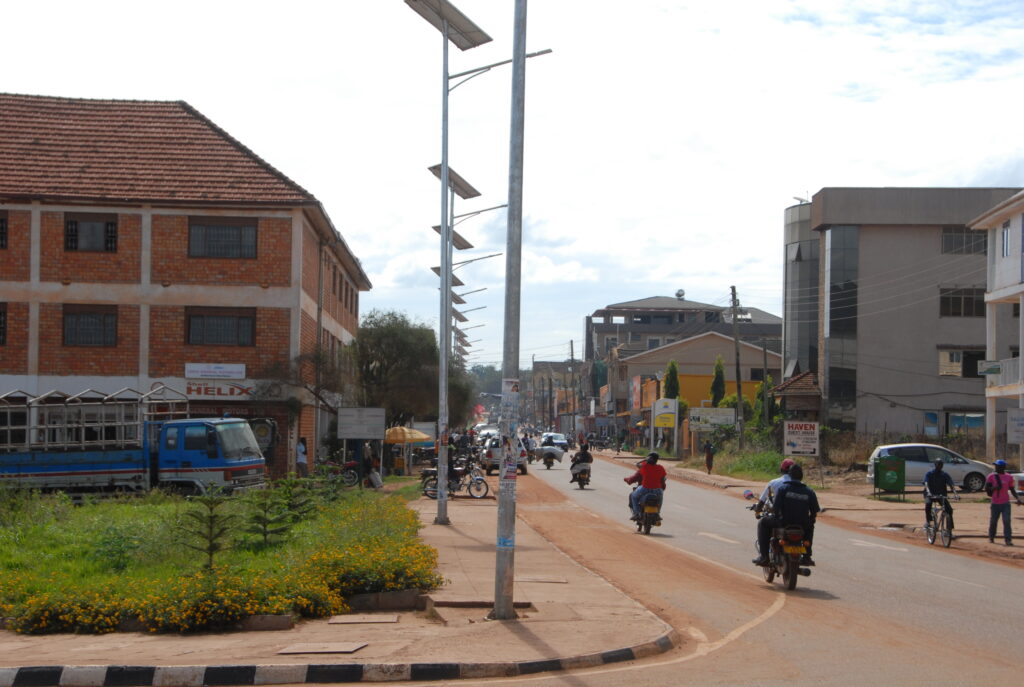On September 16, 2022, some residents of Hoima city protested over an Indian investor’s failure to demolish a building that they allege was constructed in a road and consequently, their leader Moses Aguda, was arrested.
Aguda a former contestant in the Hoima East Division parliamentary elections also doubles as the coordinator for National Unity Platform (NUP) in Bunyoro sub-region.
The ‘peaceful’ demonstration followed continuous demands for the demolition of the building that started way back in August, this year. The group alleges that the building’s existence has stalled the tarmacking of Rwentuha road measuring up to 0.45 km.
The stretch is part of 4.2km roads up for tarmacking by the Uganda National Roads Authority (UNRA).
The building, housing Kingstar hardware shop, belongs to two brothers only identified as Swale and Alli, and reports indicate that they bought it from Anthony Kimera in 2012.
Alli told The Albertine Journal that they have an approved building plan and a land title issued in 1969.
However, Brian Kaboyo, the Hoima City Mayor, distances himself from the incident, saying the title and building plan in question were approved by the previous councils.
“We have nothing to do about it. There is no way we can demolish the building. At the moment we have no money for compensation,” Kaboyo said, citing another example of Link Bus terminal where a piece of land and toilet were removed to pave way for another road construction.
The Indian investors’ and Link Bus terminal stories are, sadly, far from unique. A survey by The Albertine Journal indicates that Hoima, which was elevated to a city status in July 2019, faces a challenge of physical planning.
According to Wikipedia, physical planning is the active process of organising the physical activities and land uses in order to ensure orderly, effective sitting and proper coordination.
However, Hoima City comprised of East and West Divisions with a cover of 228 square kilometres and a road network of 600 kilometres, faces challenges of urbanisation such as natural population increase and rural to urban migration.
Following the discovery of oil and gas in the area, people now flock the place in multitudes either to invest, or look for jobs and consequently, the Central Business District (CBD) has witnessed a boom in construction of new buildings.
But, the City’s planning department is not guiding the developers on what instructions to follow before establishing their buildings.
Experts cite incompetence, understaffing and corruption in the physical planning department and lack of political will to drive systems forward.
The 2017-2040 physical development plan outlines a set of guiding plans for how buildings, roads and infrastructures will be stationed, where and how and the general land use. However, not all people in the city have approved building plans
The Albertine Journal has established that some of the building plans are approved when construction is already ongoing, a claim the authorities contest.
“A first time visitor sees a city which is growing out of excitement, uncoordinated and not well planned. The roads and facilities are located in the CBD as opposed to being spread in the outskirts of the city for proper planning and decongesting of the urban area,” an urban planning expert said on condition of anonymity.
The national population census of 2014 by Uganda Bureau of Statistics (UBOS) indicated that Hoima had a population growth rate of 10.7% coming second to Wakiso town with 11.9%.
John Apuuli, a resident of Hoima city, said that urban transformation requires spaces for a range of socio-economic activities such as recreation, transport, sanitation, solid waste management amongst others.
Apparently, the district has only Boma grounds as the remaining green space. Reports indicate that some pieces of land have fallen victim to grabbers while some have been sold off by some ‘unscrupulous’ officials.
When contacted, Kyaboga Kakiiza the President of the City Development Forum said: “Important lessons from rapidly urbanising areas in the world need to be taken note of.”
He warns that if proper planning remains unattended, there is likely to be resistance to development by the citizens in future.
“There will be resentment towards development because the population might not approve of their projects being demolished,” Kakiiza said.
But Kaboyo has a suggestion: “We want the government to fund us and we repeat detailed physical planning. In the old physical plan, only the Kanenankumba suburb was planned.”
He says council has to embark on recruitment of more personnel to do the detailed plan while citing inadequate funding and failure to enforce the existing urban laws due to a shortage of enforcement officers.
“For example, the city needs close to 20 enforcement officers and yet at the moment they have only two town agents,” he said.
Hoima City is still operating on the municipal setup with only 37% of staffing level implying that out of 10 people only 3 positions are filled.
Kaboyo said planning of the city requires heavy involvement and participation of all stakeholders.
In a study titled: Understanding urban land, politics, and planning: a critical appraisal of Kampala’s urban extension shows that community engagement in the process of land and planning is vital.
The study explains that political power relations seem to influence if not determine social conditions at the grassroots level, without which planning will remain an abstract norm.
The study refers to policymakers, housing departments, politicians, the community, and academic institutions who form part of the community engagement.
The study says the multi-layered land rights seem to be the origin of land challenges experienced in the city today.
For example, the registered owner with title and equitable ownership by virtue of occupation is problematic.
The same is echoed by Solomon King Byamukama, a legal officer at Mid-Western Region Anti-Corruption Coalition (MIRAC) who says in this case, council cannot demolish his building as a registered property owner-with an approved building plan and a title without him being duly compensated.
He said buildings can be demolished in case one does not have an approved building plans or a land title.



